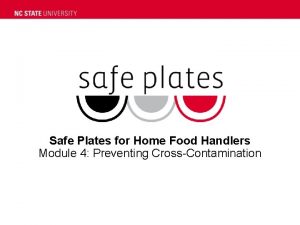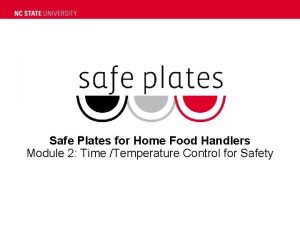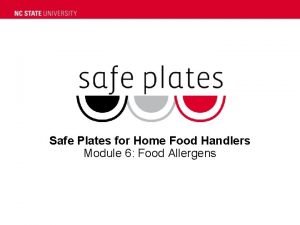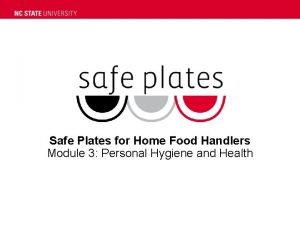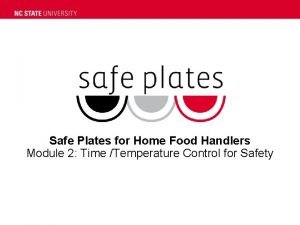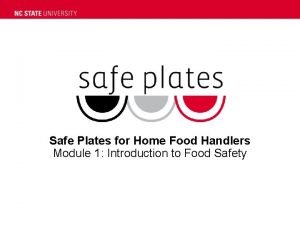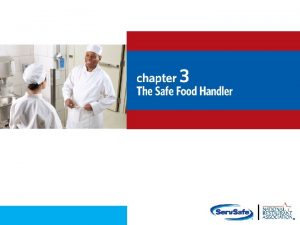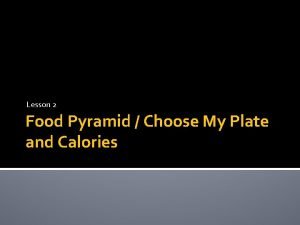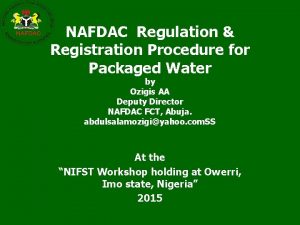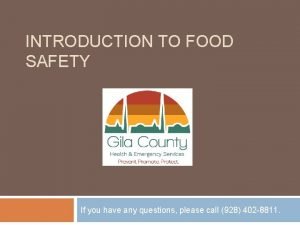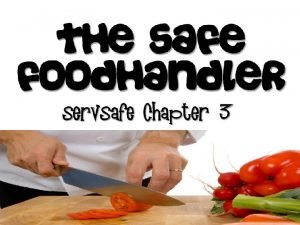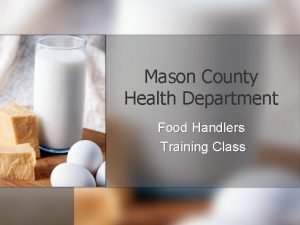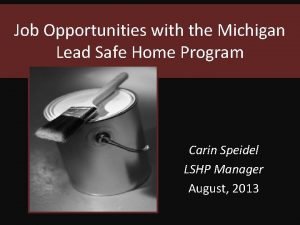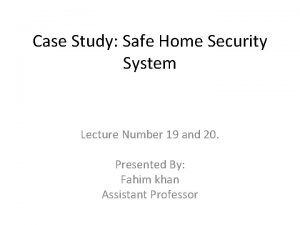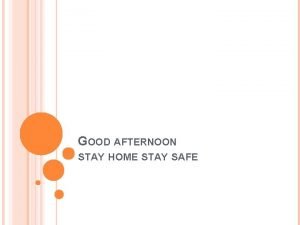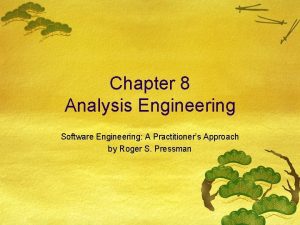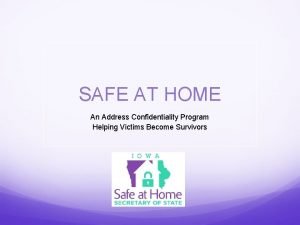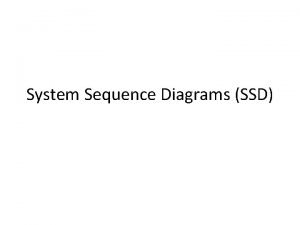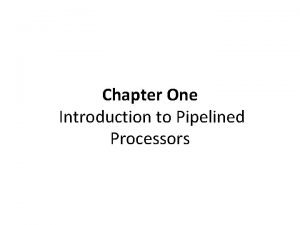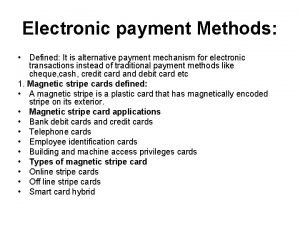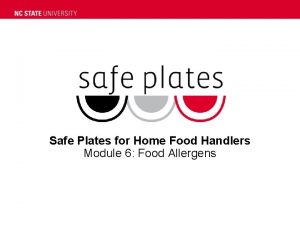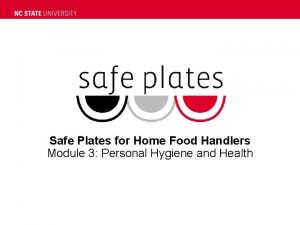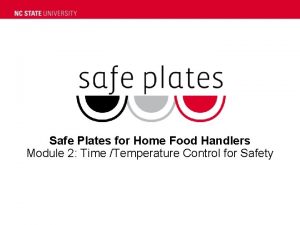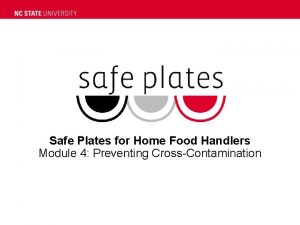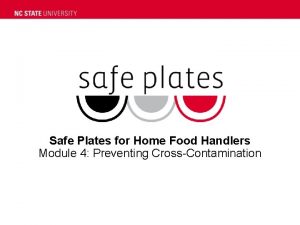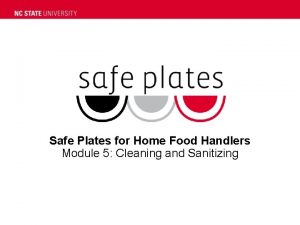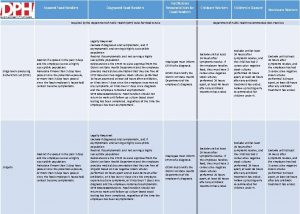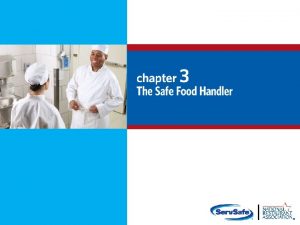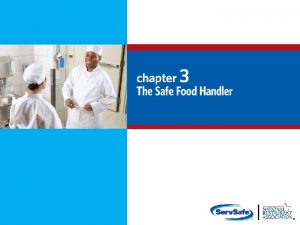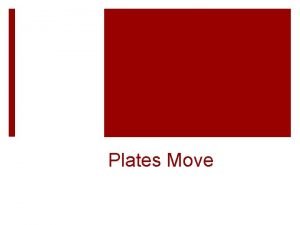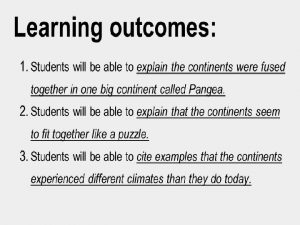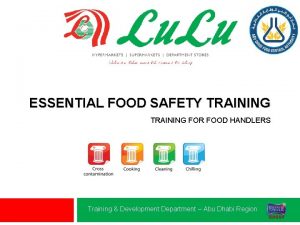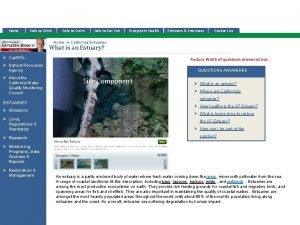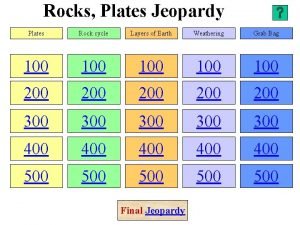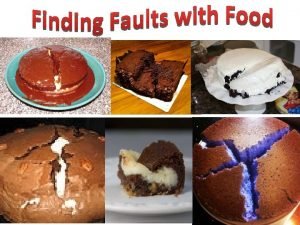Safe Plates for Home Food Handlers Module 2




























- Slides: 28

Safe Plates for Home Food Handlers Module 2: Time /Temperature Control for Safety

Case Study

What Happened February 2017, Lake City, FL • 200 students, chaperones, teachers and college faculty got sick at a Science Olympiad competition • Lunch was made by volunteers • People started getting sick after consuming lunch • 50 people had to go to the hospital in ambulances

What They Found • Pulled pork was positive for Staphylococcus aureus toxin • Staphylococcus aureus bacteria is found on human hands, skin, nose and throat • When the bacteria gets into food that is not kept hot or cold it grows and makes a poison • Volunteer probably handled pulled pork with poor personal hygiene and then left it at room temperature

Learning Objectives • Understand some foods require time and temperature control to reduce the risk of foodborne illness • Define the Temperature Danger Zone (TDZ) • Identify required times and temperatures for refrigerated storage • Identify the appropriate cooking times and temperatures for different foods

Learning Objectives • Explain correct use of thermometers • Apply proper methods and time/temperature combinations for cooling food to reduce the risk of foodborne illness • Identify methods for safely thawing, reheating, hot and cold holding of TCS foods

Key Terms • Commercially processed – a food that has undergone temperature treatments, processing and/or packaging by a government-inspected facility • Core/internal temperature – temperature in the last place of the food to be heated • Temperature abuse – when food is left in the temperature danger zone for an extended period of time or does not reach its safe internal temperature

Key Terms • Temperature Danger Zone (TDZ) – the range that is above 41°F and below 135°F where bacteria grows the fastest • Time/Temperature Control for Safety – a food that requires strict control of time and temperature to limit bacterial growth and/or toxin formation • Ready-to-eat foods – foods that can be consumed without preparation or treatment, such as washing or cooking, immediately before they are eaten

Time/Temperature Control for Safety Foods

Factors that Determine TCS Food

Examples of TCS Foods • Animal Products – Raw and cooked meat and poultry – Foods made from meat or poultry stocks – Milk and dairy products – Raw shell eggs, uncooked or lightly cooked eggs or products containing them – Raw or cooked fish and shellfish

Examples of TCS Foods • Produce and Grains – Cooked grains – Heat treated plants – Cut tomatoes – Cut melons – Cut leafy greens – Raw seed sprouts – Untreated garlic and oil mixtures Why are some foods only TCS when they are cut?

Storing TCS Foods • Store food to prevent contamination • Keep food out of the TDZ • Food stored at 41 o. F or below may be kept for 7 days Anything in this picture look risky?

Monitoring Temperature

Thawing Frozen Food 1. In refrigerator/cooler at 41°F or lower 2. In microwave oven – Only if food is cooked immediately after and manufacturer’s instructions are followed 3. In package submerged under running potable water at 70°F or lower 4. As part of cooking process

Cooking Temperatures and Times INTERNAL COOKING FOOD ITEM TEMPERATURE 130°F for 112 minutes • Roast beef 145°F for 4 minutes 135°F for 15 seconds • Commercially processed, fully cooked foods • Raw eggs to be served right away 145°F for 15 seconds • Fish • Meat, including pork, beef and lamb

Cooking Temperatures and Times INTERNAL COOKING FOOD ITEM TEMPERATURE • Raw eggs not for immediate service 155°F for 15 seconds • Anything ground, tenderized or injected (except poultry) 165°F for 15 seconds • Poultry • Anything stuffed • Stuffing containing fish, meat & poultry • Wild game animals • Reheated foods 165°F, held for 2 min • Food cooked in a microwave oven

Measuring Temperature • Temperature should be monitored during thawing, cooking, cooling, reheating and holding • Use a calibrated thermometer • Always measure temperature at the cold spot • Stir liquid foods before measuring temperature

Holding, Cooling and Reheating

Hot and Cold Holding • Hot foods should be cooked to the proper internal temperature and held at or above 135°F – Stir foods periodically to prevent cold spots • Cold foods should be cooled to the proper temperature and held at or below 41°F • Foods should be covered or held in such a way to prevent contamination

Time as a Public Health Control TCS food can remain without temperature control for up to 4 hours under certain conditions • Foods must be marked with start time • Starting temperature must be at or above 135°F or at or below 41°F • Foods are thrown away after 4 hours • If food starts at 41°F or lower, continually monitored and doesn’t go above 70°F, it can be held for 6 hours

Time as a Public Health Control • Applications for TPHC: – Buffets – Parties and community events – Meal delivery – Packing lunches – Leftovers

Cooling Temperature Requirements • Cool TCS food from 135°F to 41°F or lower in 6 hours – Step 1: 135°F to 70°F within 2 hours – Step 2: 70°F to 41°F within 4 hours • If food is cooled to from 135°F – 70°F in less than 2 hours, you still have 6 total hours to reach 41°F • If food has not reached 70°F in 2 hours, it must be thrown out or reheated to 165°F and used for immediate service or cooled correctly

Best Cooling Procedures • Divide food into smaller portions, and/or place in small shallow containers • Monitor with tip-sensitive digital thermometer • Use an ice water bath • Stir to increase cooling rate • Loosely cover containers

Cooled Foods • Properly cooled food can only be kept 7 days at 41°F • Freezing stops the clock, storage time starts again when thawed • When mixing older items with new items use the older date • Minimize leftovers by only cooking what you need

Reheating Food • Heating food to hold hot: – Food must reach 165°F for 15 seconds within 2 hours – Dispose of reheated food if it does not reach 165°F in 2 hours • No minimum temperature for foods that will be eaten right away • Throw away uneaten reheated food

Discussion How would you explain to someone the risks of leaving leftover chicken salad out on the counter all afternoon?

Review • Time/temperature control for safety foods • Times, temperatures and date marking for refrigerated storage • Monitoring temperature of TCS foods • Holding, cooling and reheating food
 Safe plates module 4
Safe plates module 4 Safe plates
Safe plates Module 6 food
Module 6 food Henss food safety
Henss food safety Safe plates module 2
Safe plates module 2 Safe plates module 1
Safe plates module 1 Food handlers can contaminate food when they
Food handlers can contaminate food when they When should hand antiseptics be used
When should hand antiseptics be used Choose my plat.gov
Choose my plat.gov Safe feed safe food
Safe feed safe food Nafdac food handlers test
Nafdac food handlers test Gila county food handlers
Gila county food handlers When should hand antiseptics be used
When should hand antiseptics be used 123 food handlers
123 food handlers Safe people safe places
Safe people safe places Michigan lead safe home program
Michigan lead safe home program Use case diagram for safehome security system
Use case diagram for safehome security system Good afternoon stay safe and healthy
Good afternoon stay safe and healthy Activity diagram for access camera surveillance
Activity diagram for access camera surveillance Safe at home participant
Safe at home participant Good morning stay at home
Good morning stay at home Draw the context level dfd for the safe home software.
Draw the context level dfd for the safe home software. On an ssd, a dashed arrow usually represents what?
On an ssd, a dashed arrow usually represents what? Handlers classification
Handlers classification Payment handlers meaning
Payment handlers meaning Unit 2 food food food
Unit 2 food food food Food chain food chain food chain
Food chain food chain food chain C device module module 1
C device module module 1 Perbedaan home care dan home service
Perbedaan home care dan home service
